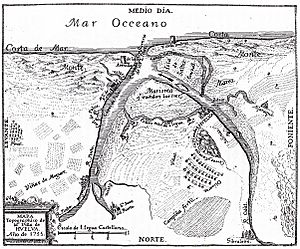Saltes Island facts for kids

Saltes Island (called Isla Saltés in Spanish) is a small island in the Huelva River estuary in Spain. It is part of the Odiel Marshes biosphere reserve. This means it is a special protected area for nature.
Contents
Where is Saltes Island Located?
Saltes Island is the most southern island in the Odiel Marshes Natural Park. This park is the second largest wetland in Andalusia, a region in Spain. The island sits where two rivers, the Odiel and the Rio Tinto, meet.
Most of the island is swamp land. It also has sandy ridges that can be up to 3 meters (about 10 feet) high.
Amazing Wildlife on Saltes Island
Saltes Island is home to many plants and animals. It is a very important place for different kinds of birds. You can see spoonbills, flamingos, egrets, and storks living here.
A Look into Saltes Island's Past
Saltes Island and the nearby city of Huelva might be where an ancient, possibly mythical, city called Tartessos once stood. A Roman poet named Avienius described Tartessos as an "island between two rivers."
Long ago, in the 8th century BC, Greek people sailed to this area. They were told to build a temple for Hercules here. Later, around the 7th century BC, Tartessos started to be influenced by Greek culture.
Discoveries from Ancient Times
Archaeologists have found interesting things on Saltes Island. They found signs of Roman buildings used for fishing and making sea salt. They also found parts of an 11th-century Muslim city called Salthish. This city was part of a small kingdom known as the Taifa of Saltés and Huelva.
Studies suggest that Salthish had a main fortress about 70 by 40 meters (230 by 130 feet) in size. The people living there worked with metals. They used minerals that came from mines to the north, brought down the river now called Rio Tinto. Because it was by the sea, the city was also involved in fishing and other types of trade.
The city of Salthish slowly became empty after 1052. This was when another kingdom, the Taifa of Seville, took control. The city continued to decline even more in later Christian times.
On July 17, 1381, a sea battle happened near Saltes Island. This was during the Third Ferdinand War. The Castilian admiral, Fernando Sánchez de Tovar, saw the Portuguese fleet. The Portuguese fleet was led by João Afonso Teles de Menezes.
Even though he had fewer ships, de Tovar pretended to retreat towards Seville. The Castilian ships were fast, which made the Portuguese ships break their formation. Some Portuguese ships even started attacking fishing boats on the island.
De Tovar's retreat was a trick! When he saw the Portuguese ships were scattered, the Castilians attacked in a tight group. They captured 22 out of 23 Portuguese ships.
Saltes Island During the Spanish Civil War
In the 20th century, during the Spanish Civil War, a camp was set up on Saltes Island. This camp held prisoners. Even though it was officially meant for fewer than 2,000 people, some reports say more than 5,000 prisoners were held there. By March 1939, 3,197 prisoners were crowded into the camp in very difficult conditions. The camp was open from at least February to September 1939.
See also
 In Spanish: Isla Saltés para niños
In Spanish: Isla Saltés para niños

